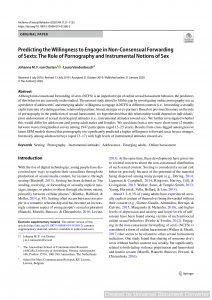Cybercrimes
Predicting the Willingness to Engage in Non-Consensual Forwarding of Sexts
 Full Article Title: Predicting the Willingness to Engage in Non-Consensual Forwarding of Sexts: The Role of Pornography and Instrumental Notions of Sex
Full Article Title: Predicting the Willingness to Engage in Non-Consensual Forwarding of Sexts: The Role of Pornography and Instrumental Notions of Sex
Open Access: Yes
Abstract
Although non-consensual forwarding of sexts (NCFS) is an important type of online sexual harassment behavior, the predictors of this behavior are currently understudied. The present study aimed to fill this gap by investigating online pornography use as a predictor of adolescents’ and emerging adults’ willingness to engage in NCFS in different contexts (i.e., forwarding a sexually explicit picture of a dating partner, relationship partner, friend, stranger or ex-partner). Based on previous literature on the role of pornography in the prediction of sexual harassment, we hypothesized that this relationship would depend on individuals’ prior endorsement of sexual stereotypical attitudes (i.e., instrumental attitudes toward sex). We further investigated whether this would differ for adolescent and young adult males and females. We used data from a two-wave short-term (2 months between waves) longitudinal survey among 1947 participants (aged 13–25 years). Results from cross-lagged autoregressive latent SEM models showed that pornography use significantly predicted a higher willingness to forward sexts from a stranger, but mostly among adolescent boys (aged 13–17) with high levels of instrumental attitudes toward sex.
Citation
van Oosten, J. M. F., & Vandenbosch, L. (2020). Predicting the willingness to engage in non-consensual forwarding of sexts: the role of pornography and instrumental notions of sex. Archives of Sexual Behavior, 49(4), 1121–1132. https://doi.org/10.1007/s10508-019-01580-2

